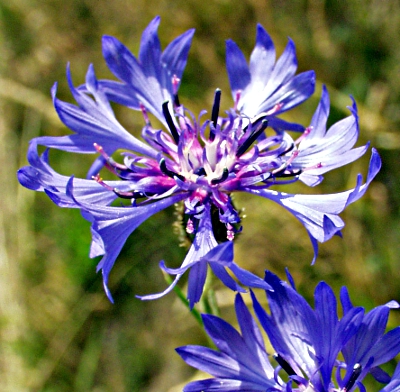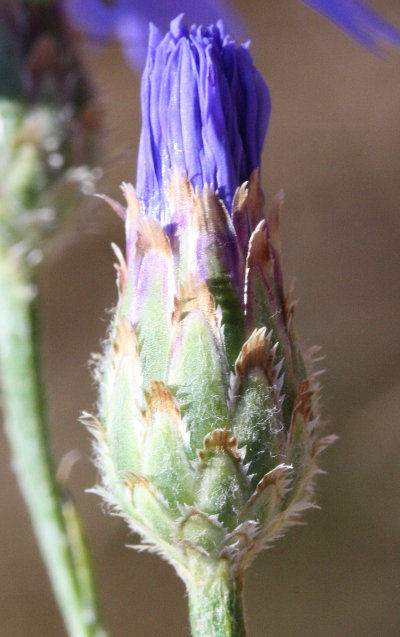Cyanus |

Cyanus is the Latinized name of gr. cyanos and refers to the mostly blue flowers

Bud of the cornflower
De Candolle in 1838 removed the taxon in the genus established in 1753 by Linnaeus, to gave it the rank of a section. In 2003 the generic status of Cyanus was restored by Greuter.
Comprising 20–25 species, the genus is native to Europe, North Africa, Asia Minor and the Caucasus. Today, due to the use as ornamental plants and by contaminated seed, spread all over the world. Members of Cyanus are annual to perennial herbs with erect or ascending, sometimes branched and angular stems. The basal leaves and the stem leaves are cobwebby to tomentose, often decurrent, arranged alternate, sessile or stalked. The lower stem leaves are sometimes lyrate to pinnatilobate, the upper ones are often undivided.
The flower heads are arranged solitary or they are united in racemose to corymbose inflorescences. The blue, blue-violet, pink or cream-colored, rarely white heads consist only of tubular florets, whereby the outer ones are greatly elongated, zygomorphic and sterile. They form 3–10 mm long corolla lobes. The inner florets are more actinomorphic, bisexual and have 5 elongated corolla lobes. Florets at the base without chaffy leaves. The receptacle is flat and spiny. The involucre is ovate and consists of several rows of scale-like arranged, hairy phyllaries with thornless appendages with serrated or ciliate margins.
After pollination by butterflies or Hymenoptera a barrel-shaped, slightly flattened nut fruit (achene) with a bristly pappus emerged from the calix, or rarely completely without a calyx. The achenes are bearded or tufted at the base (navel).
| Floral formula: |
| * K0 or K=pappus [C(5) A5(connate)] G(2) inferior |
Historiscal publications
Pliny (about 23–79 AD.) pointed out that in the name of Cyanus the color were to recognize. The plant was at the time of Alexander the Great (356–323 AD) not yet known, since it was not mentioned shortly after his death by any authors. However it was discovered by the Greeks, as its name shows.
Hildegard of Bingen (1098–1179) wrote about Centaurea that the root taken with wine or water would glue fractures. The herb squeezed in warm water and placed on the skin over the fracture, would also help. Taken with wine or water or processed with fresh deer tallow and flour to small cakes, it drives away gout. It is not certain whether the Holy Hildegard meant the centaury or the cornflower.
Leonhart Fuchs (1501–1566) writes about the "blaw Kornblum" (Cyanus segetum), it was very common and would grow occasionally in all kinds of fields. They would bloom in June and July and was very pleasant to the eye. The common people would use it in wreaths. As a medicinal herb, crushed and placed on the skin, it would help against sore eyes and other inflammations. The juice or dried herb would assist against putrefying sores.Meaning of the species name
- segetum: lat. segetus = growing in cornfields
Interesting notes
Dried tubular florets of the cornflower are added some herbal teas as "splash of color".
Different breeds of Cyanus segetum – e.g. forms with double flowers in different pastel colors – are used as ornamental plants.